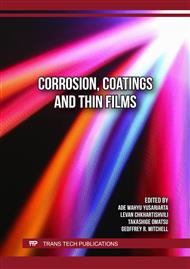p.3
p.13
p.23
p.35
p.47
p.55
p.67
p.73
Effect of Electropolishing Time and Distance on Roughness and Corrosion Resistance of AISI 316L Elbow Pipe for Pharmaceutical Industry Using H2SO4-H3PO4 Solution
Abstract:
The manufacturing industry has experienced tremendous growth in recent years. According to the Badan Pusat Statistik (BPS), the percentage of the manufacturing industry rise from 3.89% to 5.87%. This also applies to the pharmaceutical industry, where polishing of surface material is one of main factor in pharmaceutical industry. Electropolishing is one of the finishing stages that can be done to improve polishing of material surface. Electropolishing is an electrochemical polishing technique that incorporates an electrolytic-electric solution. This process works by dissolving a controlled anodic metal surface in an appropriate electrolyte. This makes it possible to increase the evenness of the metal surface. For the pharmaceutical equipmentded industry stipulates ASME BPE and ASME B46.1 standards for surface finish materials with an electropolish surface finish value is 0.38 µm. This study aims to determine the cathode-anode distance and time to electropolishing the surface of AISI 316L stainless steel material for pharmaceutical equipment with various suggested parameters. Metallographic and SEM (Scanning Electron Microscope) tests were also carried out to see the morphological results. The experimental results show that electropolishing with H2SO4 98% (40% v) and H3PO4 85% (60%v) solution, the distance and duration of the electropolishing process are correlated with each other; the closer and longer the process will give lower roughness results. The lowest roughness obtained is 0.141 µm with distance 5 cm and process duration of 10 minutes. For the corrosion rate is carried out using potentiodynamic polarization with a corrosion rate value obtained 0,001 mpy.
Info:
Periodical:
Pages:
13-22
Citation:
Online since:
October 2025
Price:
Сopyright:
© 2025 Trans Tech Publications Ltd. All Rights Reserved
Share:
Citation:


